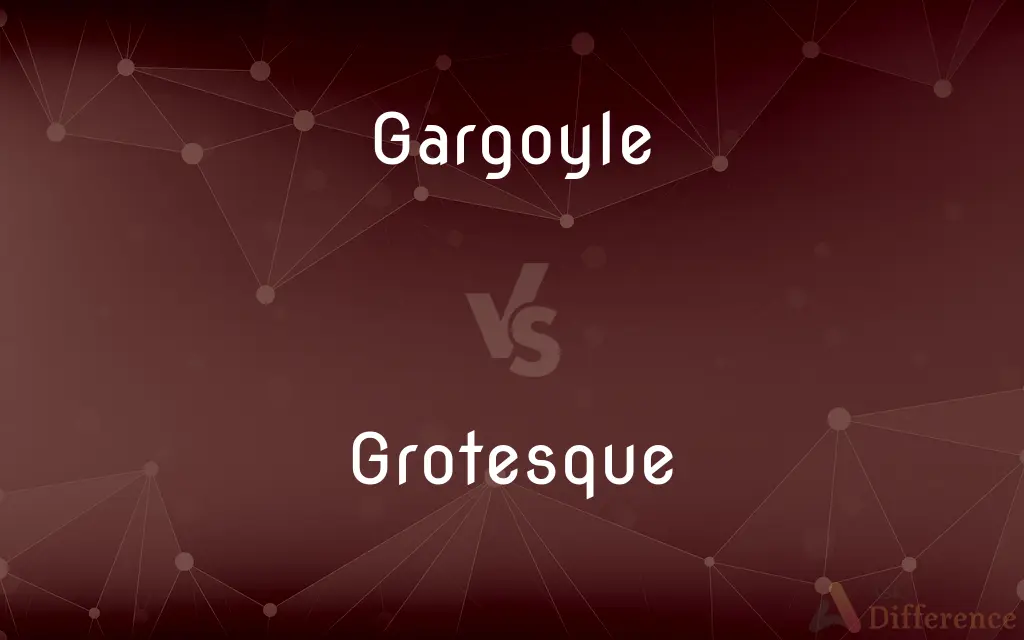Gargoyle vs. Grotesque — What's the Difference?
By Tayyaba Rehman & Urooj Arif — Updated on April 2, 2024
Gargoyle often serves a practical purpose, such as conveying water away from a building, whereas grotesque is purely decorative, adding architectural interest and variety without functional duty.

Difference Between Gargoyle and Grotesque
Table of Contents
ADVERTISEMENT
Key Differences
Gargoyles are architectural elements designed with a functional purpose in mind, typically to convey water from roofs away from the sides of buildings to prevent erosion. They are often carved into the shape of a mythical creature or monster. On the other hand, grotesques are decorative sculptures that do not serve a functional purpose. They are also often designed to represent mythical or fantastical creatures, but their primary role is to add to the aesthetic and symbolic value of the architecture.
While gargoyles are specifically designed to act as water spouts, grotesques serve as ornamental figures that might be found on any part of a building, not necessarily on the roof or edges. This distinction means that while both can contribute to the overall theme or mood of a building, gargoyles have a clear, utilitarian role in addition to their decorative aspect.
Gargoyles are typically found on historical buildings, such as Gothic cathedrals, where their functional design was integrated into the architecture from the outset. Grotesques, while also prevalent in historic architectures, can be found in a wider variety of contexts, including modern buildings where they serve as nods to architectural tradition or simply as artistic elements.
In terms of symbolism, gargoyles often embody protection, designed not only to physically protect buildings from water damage but also symbolically to ward off evil spirits. Grotesques, while they may also carry symbolic meanings, such as embodying the grotesque or the fantastical, their significance is more varied and less tied to a specific symbolic function.
Both gargoyles and grotesques reflect the artistic and cultural values of the times and places in which they were created. However, the necessity of gargoyles for water drainage in architecture has diminished with modern building techniques, making their use more historical or aesthetic, whereas grotesques continue to be used primarily for their artistic and symbolic value.
ADVERTISEMENT
Comparison Chart
Purpose
Functional as water spouts
Purely decorative
Location
Typically on roofs or edges of buildings
Can be found anywhere on a building
Symbolism
Often symbolize protection
Symbolism varies, often embodies the fantastical or grotesque
Historical Use
Integral to Gothic architecture
Used across various architectural styles
Modern Use
Aesthetic or historical replication
Continues as decorative art in architecture
Compare with Definitions
Gargoyle
Often mythical or monstrous in appearance.
The gargoyle's fierce expression is meant to ward off evil.
Grotesque
Symbolism varies widely, often more playful or enigmatic.
Each grotesque on the building seems to tell its own mysterious story.
Gargoyle
Integral to Gothic architectural design.
Gargoyles are a hallmark of the Gothic style seen in many European cathedrals.
Grotesque
Decorative sculpture not intended as a water spout.
The library's facade features a series of grotesques depicting medieval scholars.
Gargoyle
A carved stone figure with a spout designed to convey water from a roof.
The cathedral's gargoyles are sculpted to look like dragons.
Grotesque
Can represent humans, animals, or fantastical creatures.
A grotesque with the body of a lion and the head of a man adorns the gate.
Gargoyle
Historically functional sculptures that also serve decorative purposes.
Each gargoyle on the building serves to divert rainwater.
Grotesque
Found in both historical and modern buildings.
Modern buildings use grotesques to add a touch of whimsy.
Gargoyle
Symbolizes protection against both physical and spiritual harm.
Medieval builders believed gargoyles protected the building from both water damage and evil spirits.
Grotesque
Used for aesthetic and symbolic purposes in architecture.
The grotesque figures are thought to represent the seven deadly sins.
Gargoyle
In architecture, and specifically in Gothic architecture, a gargoyle () is a carved or formed grotesque with a spout designed to convey water from a roof and away from the side of a building, thereby preventing rainwater from running down masonry walls and eroding the mortar between. Architects often used multiple gargoyles on a building to divide the flow of rainwater off the roof to minimize the potential damage from a rainstorm.
Grotesque
Since at least the 18th century Italy (in French and German as well as English), grotesque has come to be used as a general adjective for the strange, mysterious, magnificent, fantastic, hideous, ugly, incongruous, unpleasant, or disgusting, and thus is often used to describe weird shapes and distorted forms such as Halloween masks. In art, performance, and literature, however, grotesque may also refer to something that simultaneously invokes in an audience a feeling of uncomfortable bizarreness as well as sympathetic pity.
Gargoyle
A grotesque carved human or animal face or figure projecting from the gutter of a building, typically acting as a spout to carry water clear of a wall.
Grotesque
Comically or repulsively ugly or distorted
A figure wearing a grotesque mask
Gargoyle
A roof spout usually in the form of a grotesque or fantastic creature projecting from a gutter to carry rainwater clear of the wall.
Grotesque
A very ugly or comically distorted figure or image
The rods are carved in the form of a series of gargoyle faces and grotesques
Gargoyle
A grotesque ornamental figure or projection.
Grotesque
A family of 19th-century sans serif typefaces.
Gargoyle
A person of bizarre or grotesque appearance.
Grotesque
Characterized by ludicrous, repulsive, or incongruous distortion, as of appearance or manner.
Gargoyle
A carved grotesque figure on a spout which conveys water away from the gutters.
Grotesque
Outlandish or bizarre, as in character or appearance.
Gargoyle
Any decorative carved grotesque figure on a building.
Grotesque
Of, relating to, or being the grotesque style in art or a work executed in this style.
Gargoyle
A fictional winged monster.
Grotesque
One that is grotesque.
Gargoyle
(pejorative) An ugly woman.
Grotesque
A style of painting, sculpture, and ornamentation in which natural forms and monstrous figures are intertwined in bizarre or fanciful combinations.
Gargoyle
A spout projecting from the roof gutter of a building, often carved grotesquely.
Grotesque
A work of art executed in this style.
Gargoyle
A spout that terminates in a grotesquely carved figure of a person or animal
Grotesque
Distorted and unnatural in shape or size; abnormal, especially in a hideous way.
Gargoyle
An ornament consisting of a grotesquely carved figure of a person or animal
Grotesque
Disgusting or otherwise viscerally revolting.
Grotesque
(typography) Sans serif.
Grotesque
A style of ornamentation characterized by fanciful combinations of intertwined forms.
Grotesque
Anything grotesque.
Grotesque
(typography) A sans serif typeface.
Grotesque
Like the figures found in ancient grottoes; grottolike.
Grotesque
Wildly or strangely formed; whimsical; extravagant; of irregular forms and proportions; fantastic; ludicrous; antic.
Grotesque
A whimsical figure, or scene, such as is found in old crypts and grottoes.
Grotesque
Artificial grotto-work.
Grotesque
Art characterized by an incongruous mixture of parts of humans and animals interwoven with plants
Grotesque
Distorted and unnatural in shape or size; abnormal and hideous;
Tales of grotesque serpents eight fathoms long that churned the seas
Twisted into monstrous shapes
Grotesque
Ludicrously odd;
Hamlet's assumed antic disposition
Fantastic Halloween costumes
A grotesque reflection in the mirror
Common Curiosities
How do gargoyles protect buildings?
Gargoyles protect buildings by directing rainwater away from the structure's walls, reducing erosion and water damage.
What is the primary difference between a gargoyle and a grotesque?
A gargoyle is designed to convey water away from a building, serving a functional purpose, whereas a grotesque is purely decorative.
Are gargoyles always scary or monstrous?
While traditionally gargoyles are depicted as monstrous or fearsome creatures, their design can vary widely.
Where are gargoyles most commonly found?
Gargoyles are most commonly found on Gothic cathedrals and historical buildings, often in Europe.
Can grotesques be found on interior designs?
Yes, grotesques can also adorn interior spaces, contributing to the aesthetic and thematic elements of the design.
Do all Gothic cathedrals have gargoyles?
While many Gothic cathedrals feature gargoyles, it's not a universal characteristic; some may use simpler water spouts.
Do grotesques serve any functional purpose in modern architecture?
In modern architecture, grotesques serve primarily decorative roles, adding artistic value rather than functional utility.
Can gargoyles be considered grotesques?
Yes, gargoyles can be considered a subset of grotesques when they are designed for both functional and decorative purposes.
Why were gargoyles and grotesques popular in medieval architecture?
They were popular for their functional role, symbolic protection, and as a canvas for artisans to explore themes of morality and mythology.
Is there a cultural significance to gargoyles and grotesques?
Both gargoyles and grotesques carry cultural and symbolic significance, reflecting the beliefs, myths, and artistic styles of their times.
What kind of creatures are depicted as gargoyles?
Gargoyles are often depicted as mythical or fantastical creatures, including dragons, demons, and chimeras.
Do gargoyles have any religious significance?
In some contexts, gargoyles have been attributed religious significance, symbolizing the protection of sacred spaces from evil.
Are grotesques always made of stone?
Although stone is traditional, grotesques can be made from various materials, including wood, metal, and plaster.
Can modern buildings have gargoyles?
Yes, modern buildings can feature gargoyles, often as nods to architectural history or for aesthetic purposes.
How are grotesques different from other decorative sculptures?
Grotesques specifically embody the grotesque or fantastical and are associated with architectural decoration, distinguishing them from other sculptures.
Share Your Discovery

Previous Comparison
Earthy vs. Earthly
Next Comparison
Department vs. SchoolAuthor Spotlight
Written by
Tayyaba RehmanTayyaba Rehman is a distinguished writer, currently serving as a primary contributor to askdifference.com. As a researcher in semantics and etymology, Tayyaba's passion for the complexity of languages and their distinctions has found a perfect home on the platform. Tayyaba delves into the intricacies of language, distinguishing between commonly confused words and phrases, thereby providing clarity for readers worldwide.
Co-written by
Urooj ArifUrooj is a skilled content writer at Ask Difference, known for her exceptional ability to simplify complex topics into engaging and informative content. With a passion for research and a flair for clear, concise writing, she consistently delivers articles that resonate with our diverse audience.
















































